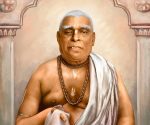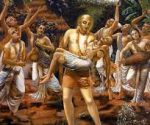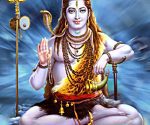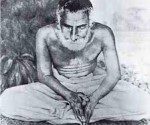Vyasa-puja
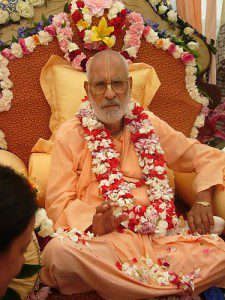 by Sri Srimad Bhaktivedanta Srila Narayana Gosvami Maharaja
by Sri Srimad Bhaktivedanta Srila Narayana Gosvami Maharaja
My heartly dandavat pranama at the lotus feet of my spiritual master, nitya-lila pravista om visnupada Sri Srimad Bhakti Prajnana Kesava Gosvami Maharaja, my entire guru-paramapara, and my siksa-guru, nitya-lila-pravista om visnupada Sri Srimad Bhaktivedanta Svami Maharaja.
Today we are going to observe guru-puja, or Vyasa-puja. First of all we should know what is guru-puja and what is Vyasa-puja. Both are the same. Sri Krsna Dvaipayana Vedavyasa divided the one Veda into four. Then to reconcile, because it was difficult to extract the essence of the four Vedas, he wrote Brahma-Sutra (Vedanta-sutra).
Vedavyasa explained that the essence of the meaning of the brahma-gayatri comes from omkara. Gayatri is feminine gender. Who is Gayatri? We hear that she is the wife of Brahma, but you should know what has been told in the gayatri-mantra: “bhargo devasya dhimahi”.
Bharga means ‘power;’ that is, hladini-sakti, or mahabhava-svarupa (Radhika). The supreme reservoir of krsna-prema is Radhika. We learn that Gayatri is the wife of Brahma, but who is she actually? She is a gopi. Krsna had told Yogamaya, “Somehow, try to give this gopi to Brahma; otherwise she cannot be parakiya (My paramour beloved).” All the gopis are married to other gopas. Krsna therefore ordered Yogamaya to also arrange this for Gayatri-devi, so that her love and relationship with Krsna could be parakiya. This is why Gayatri was given to Brahma in marriage. From the beginning she had no love for Brahma; she loved only Krsna. Parakiya mood is the topmost mood, and Gayatri became the maid-servant of Radhika by that mood. We see that the essence of all the Vedic literatures is Gayatri. Gayatri is Radhika, or Her maid-servant, and that mood may come to anyone who serves this mantra.
This is a special truth. My heart told me that I should tell you this secret truth about Gayatri. This is a secret; I never told this before.
The meaning of the gayatri-mantra has been clearly revealed by Srila Vyasadeva in the first verse of Srimad-Bhagavatam. Had he not come to this world, ‘everything would have been nothing.’ He revealed this gayatri-mantra, as well as the catur-sloki of Srimad-Bhagavatam and its explanation, and he especially revealed the highest love of the mahabhava of Srimati Radhika. He revealed the meaning of Srimad-Bhagavatam, he manifested all Puranas and especially the Mahabharata, and the essence of all these scriptures is the same. Srila Vyasadeva first taught his four disciples – Jaimini, Vaisampayana, Paila, and Angira – and he especially taught his dearest one, Srila Sukadeva Gosvami. Sukadeva Gosvami was not only his son, but also his dear-most disciple. Srila Vyasadeva manifested all his knowledge in the heart of Srila Sukadeva Gosvami, who then preached it everywhere.
All acaryas, and also their disciples, in our entire guru-parampara, are so much indebted to those who are in the line of Srila Vyasadeva.
It is essential, therefore, to know the meaning of Vyasa. Suppose there is a circle. If from any point of the circumference a straight line is drawn, passing through the center to the other end, this is called Vyasa (diameter). The diameter is always straight and covers all 360 degrees of the circle. It always divides the circle in half, making it 180 degrees. This is Vyasa.
This Vyasa touches everywhere in the entire world. Srila Vyasadeva revealed the Supreme Personality of Godhead, he revealed Radhika, and he revealed all other knowledge; and we are thus unlimitedly indebted to him. Our whole guru-parampara is indebted to him, and it is for this reason that the mantra of Vyasa-puja is:
narayanam namaskrtya
naram caiva narottamam
devim sarasvatim vyasam
tato jayam udirayet
[“Before reciting this Srimad-Bhagavatam, which is the very means of conquest, one should offer respectful obeisances unto the Personality of Godhead, Narayana, unto Nara-narayana Rsi, the supermost human being, unto mother Sarasvati, the goddess of learning, and unto Srila Vyasadeva, the author.”(Srimad Bhagavatam, 1.2.4 )]
In other words, this is the mantra for worshipping Vyasa, who is the origin of Vyasa-puja. We first offer pranama to Narayana, who is Krsna Himself: “Narayanam namaskrtya.” Then,”naram caiva.” Some say that in this connection naram ca means Arjuna, and there is no harm in that* [see endnote1], but generally it means Nara-Narayana Rsi here. Then, “devim sarasvatim,” who is Sarasvati Devi. “Vyasam, tato jayam udirayet” means ‘and then to Srila Vyasadeva.’ By offering pranama in this way, one can then read or explain Mahabharata, Srimad-Bhagavatam, Vedanta-sutra, and all the Puranas. This mantra has been given in Srimad Bhagavatam, the Puranas, Mahabharata, and elsewhere.
Today is guru-puja. A disciple can observe this day in honor of any acarya, but it is especially for those following the footsteps of Srila Vyasadeva. It is especially for those who are preaching the glories of Radha-Krsna and pure bhakti everywhere. On that guru’s birthday, he performs the puja of Srila Vyasadeva, vyasa-pancaka, krsna-pancaka, panca-tattva, acarya-tattva, guru-parampara-tattva, and so on. By worship of these seven pancakas, one worships his entire guru-parampara from top to bottom. By serving and performing puja of Krsna, everything is completed – tasmin tuste jagat tusta; yet, we will have to give proper respect to all the acaryas, especially the rupanuga-acaryas.
You are saying that today is my birthday; but I do not think it is my birthday. My birthday is on Gaura Purnima, the day my Gurudeva gave me transcendental birth. Still you tell me, and the people of this world think so also, that my birthday is today. We observe Vyasa-puja on this worldly birthday [this is Srila Gurudeva’s humility, because the appearance day, or birth day of the bona fide acarya, Sri Krsna’s associate, is fully transcendental] but our real birth is that transcendental birth, which has been given by our guru – our father – and our mother is actually mantra. You should think like this.
On his own birthday, a guru, acarya, or disciple offers puja – to please his Gurudeva.
anyabhilasita-sunyam
jnana-karmady-anavrtam
anukulyena krsnanu
silanam bhaktir uttama
[“The cultivation of activities which are meant exclusively for the pleasure of Sri Krsna, or in other words the uninterrupted flow of service to Sri Krsna, performed through all endeavors of the body, mind and speech, and through the expression of various spiritual sentiments (bhavas), which is not covered by jnana and karma, and which is devoid of all desires other than the aspiration to bring happiness to Sri Krsna is called uttama-bhakti, pre devotional service.” (Bhakti-rasamrta-sindhu 1.1.11)]
What is the meaning of krsna-anukula? Who is the Krsna referred to here? He is asraya-vigraha. He is Krsna, but asraya Krsna. In other words, he is Sri Gurudeva. Through him we can gradually reach the lotus feet of Krsna, Hari, as visaya Krsna. This is the proper channel through which to worship Radha and Krsna or Sri Caitanya Mahaprabhu. If one can please his Gurudeva, not only externally but internally as well, then Vyasa-puja is truly observed. We should try to realize the internal ways in which Gurudeva pleases his Gurudeva.
yasya deve para bhaktir
yatha deve tatha gurau
tasyaite kathita hy arthah
prakasante mahatmanah
[“Only unto those great souls who have implicit faith in both the Lord and the spiritual master are all the imports of Vedic knowledge automatically revealed.” (Svetasvatara Upanisad 6.23)]
Apply this sloka (anyabhilasita-sunyam), totally and fully, at the lotus feet of your Gurudeva. I now realize something of the glories of my Gurudeva, and I cannot express the feelings of my heart towards him. He was a great ocean of mercy. He took me from the well of stool, and he wanted to place me in the ocean of rasa – into Sri Bhakti-rasamrta-sindhu and Sri Ujjvala-nilamani. By his special mercy I touched something of the glory of their truths regarding prema, sneha, maan, pranaya, raga, anuraga, bhava, and mahabhava up to madanakhya. I have understood something, but whose glory is this? I was not a learned person, and I was very insignificant. I know that I had no qualification at all; I was fully ignorant. However, by touching Gurudeva’s lotus feet and by hearing his hari-katha, I received from him all the various kinds of knowledge that I am giving to the world. I am not giving it; they are inspiring me, and it is by their mercy that I am doing something.
When I remember this, I become overwhelmed. How glorious is his mercy! If one does not touch the real glory of his Gurudeva and serve him totally, how can he please him?
A true disciple knows that his bona fide gurudeva is like Krsna, as it is written in all sastras. Srila Suta Gosvami has said:
suta uvaca
yam pravrajantam anupetam apeta-krtyam
dvaipayano viraha-katara ajuhava
putreti tan-mayataya taravo ‘bhinedus
tam sarva-bhuta-hrdayam munim anato ‘smi
[“Srila Suta Gosvami said: ‘Let me offer my respectful obeisances unto that great sage who can enter the hearts of all. When he went away to take up the renounced order of life [sannyasa], leaving home without undergoing reformation by the sacred thread or the ceremonies observed by the higher castes, his father, Vyasadeva, fearing separation from him, cried out, “O my son!” Indeed, only the trees, which were absorbed in the same feelings of separation, echoed in response to the begrieved father.'” (Srimad-Bhagavatam 1.2.2)]
Gurudeva is sarva-bhuta-sthitam (situated in everyone’s heart), like Krsna. Krsna is everywhere, and similarly you can never hide anything from your Gurudeva. You want to hide so many things, like your lust and worldly desires, but Gurudeva knows even more than Krsna, because he is so near to Krsna. You cannot cheat him. If you try to cheat him you will be cheating yourself – so do not try to do so. Reveal your heart to the lotus feet of your Gurudeva. Then you can know how to please him.
Parama-pujyapada Srila Bhaktivedanta Svami Maharaja knew and followed the order of his Gurudeva, and he preached that mission throughout the world. He has gone everywhere in the world – in jungles, in the midst of oceans, on the top of mountains, and in dangerous places like the middle of swamps (Alachua, Florida).
I went to many paces, like Saranagati and Gita Nagari, and everywhere I saw his glory. I think also that this was the glory of Srila Bhaktisiddhanta Sarasvati Gosvami Prabhupada and Srila Bhaktivinoda Thakura. If they had not ordered and inspired him, and if my gurudeva had not given him sannyasa, from where would these qualities have come?* [see endnote 2] Some want to establish him as the adi-guru and last Guru, thinking that before him there were no bona fide Gurus and after him there will be no bona fide Gurus. This is a bogus idea, and an offense in his lotus feet. Srila Bhaktivedanta Svami Maharaja never said or wrote this. He showed great honor for our guru-parampara, and especially to the rupanuga-acaryas in our line. He has not done anything independently. He has written the translation of Sri Caitanya-Caritamrta and Srimad-Bhagavatam, and he has glorified Krsna. He has done nothing new; he has given the same wine in a new bottle, just as all our previous acaryas have done. The first wine was given by Srila Vyasadeva; this credit goes to him. He is Narayana; otherwise he could not have done this.
On this day, a disciple or acarya bows down at the lotus feet of Sri Gurudeva, from where he has obtained all kinds of knowledge. You should especially know that tattva-jnana, knowledge of established philosophical truths, is not sufficient. From where will the mood to weep, as the gopis used to weep, come? Srimati Radhika is always weeping, intoxicated in krsna-prema. Krsna laments and suffers for Her, but He does not become so maddened. There are many manifestations of Radha dancing with Krsna, but for Radhika there is only one Krsna. Vyasadeva is himself Narayana, and he has revealed all this.
Perform guru-parampara puja, beginning from your gurudeva, then to the rupanuga guru-varga, and so on. 1) guru-pancaka (Sri Guru, Parama-guru, Paramesthi-guru, Paratpara-guru, Paramaparatpara-guru); 2) acarya-pancaka (Sri Sukadeva, Ramanuja, Madhva, Visnusvami, Nimbaditya); 3) vyasa-pancaka (Sri Vedavyasa, Paila, Vaisampayana, Jaimini, Sumanta); 4) sanakadi-pancaka (Sri Sanaka, Sanatkumara, Sanatana, Sanandana, Visvaksena); 5) krsna-pancaka (Sri Krsna, Vasudeva, Sankarsana, Pradyumna, Aniruddha); 6) upasya-pancaka (Sri Radhika, Krsna, Gaura, Gadadhara, Sri Gurudeva); and 7) panca-tattva (Sri Krsna Caitanya, Nityananda, Advaita Acarya, Gadadhara, Srivasa).
So I want to perform my guru-puja, or Vyasa-puja. We have not learned that we should collect abundant puspanjali from our disciples. A Guru’s first duty is to worship his Gurudeva and guru-parampara, as well as the seven pancakas. You should know this and try to follow it. It is not that the guru makes a big “Vyasa-puja” book, glorifying himself, and takes all the money and presentations for himself. This is an offense.
Srila Bhaktisiddhanta Sarasvati Thakura used to say that he would first offer anything given to him unto the lotus feet of his Gurudeva, Srila Gaura Kisora Das Babaji Maharaja. When thousands of disciples used to present offerings at his lotus feet, at the end of the presentation he would say, “I am taking it all and offering at the lotus feet of my Gurudeva. This is not my property.”
It is essential to know all these truths. We are not going to follow new, modern devotees of here and there. We want to follow the line of Srila Prabhupada Bhaktisiddhanta Sarasvati Gosvami Thakura and others in our guru-parampara, like Parama-pujyapada Srila Bhaktivedanta Svami Maharaja. I want to follow in their footsteps. I want to first do guru-puja, then guru-parampara puja, and then to the others. If you want to make some offerings, I will take it and give to the lotus feet of my Gurudeva.
I am offering whatever you have all offered to me unto the lotus feet of my guru-padapadma and guru-parampara – beginning from Brahma and coming down to Srila Bhaktivedanta Swami Maharaja – and to the devotees of Sri Caitanya Mahaprabhu who will appear in the future. I am doing pranama to all of them:
hoiyachena hoibena prabhura jata dasa
sabara carana vandon dante kori ghasa
[“Holding a straw between my teeth, I submit myself at the feet of all the servants of Mahaprabhu that were or will be.” (Sri Vaisnava-Vandana verse 6)]
I request one thing of you. Try to sincerely fulfill the desire of your Gurudeva. You will see that if you are sincere, all the Vedas, and all krsna-tattva, maya-tattva, guru-tattva, radha-tattva, and all other tattvas will enter your heart and you will be pure devotees.
I am now offering all you have offered me – all your sraddha, honor, love and affection – unto the lotus feet of my Gurudeva and guru-parampara.
First, our guru-parampara kirtana should be performed: “Krsna haite catur mukha.”
Gaura premanande.
[This talk was followed by the worship ceremony.]
[*Endnote 1– It is stated in Srimad Bhagavatam (4.1.59): “That Nara-Narayana Rsi, who is a partial expansion of Krsna, has now appeared in the dynasties of Yadu and Kuru, in the forms of Krsna and Arjuna respectively, to mitigate the burden of the world.”]
[*Endnote 2 – Of course, Srila Prabhupada’s perfection is eternal. This is merely a reference to his naravat-lila, human-like pastimes, in which he is setting example for us conditioned souls. Srila Narayana Maharaja says the same thing about Sri Caitanya Mahaprabhu, regarding His naravat-lila; that if He had not received harinama and gopala-mantra from His gurudeva, Sri Isvara-puripada, He would not have been able to accomplish His mission.]




